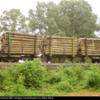I have a new one to add to my list of scratchbuilding “works-in-progress”, a 100 ton, spline log car built by Evans. It’s just slightly too modern for my normal era. Evans started building these things in 1978. A number of other builders constructed similar cars. The prototype was/is used for, basically, hauling logs, from loading points to mills, the idea being efficiency over the half dozen truck trips it would take to haul the same. These cars are in high demand presently, and will probably continue to be so, as mills are fewer, and further afield from their wood sources at times. The load can be pulpwood, hardwood, pine, really whatever.
THE PROTOTYPE -
THE MODEL, SO FAR
The car has been relatively straightforward to build, using my typical mix of laser cutting, styrene scratchbuilding, and 3d printing
The photos of the assembly board for this model, show my typical .060 acrylic core, tabbed and slotted like a model airplane. This of course makes assembly easy and without the need to mark lines with a ruler. I did glue a few laser cut assembly jigs to the board - one to keep the frame square during the initial glue up; one to aid in gluing up the two log bunks that sit on the end platforms; and a jig for cutting the angle iron diagonal supports at the car ends. On the underside you can see my “weight” - 3/8” all thread, cut and epoxied in place. The all-thread is contained by the lower flange to the center sill that has not bee glued in yet. You can also make out hexagonal cutouts in the end sub-platforms. These are for my coupler attachment method - 2mm hex nuts, sitting in the cutout, contained by the .020 end platform, and an .020 spacer not attached yet. 2mm x 8mm bolts with washers are used to attach the Kadees. If needed, additional spacers could be added to adjust height. With this method, I don’t have any penetration of the couple attachment through the deck - it’s completely hidden, and because it’s threaded, very secure, and serviceable.
I’ve upped my 3d printing game with this car, using it for more parts. I 3d printed rectangular blocks with a circular pad and 3mm threaded hole, that glues into the frame at the bolsters. These are printed with a filament printer. With a filament printer I can actually print a 3mm female threat. On a resin printer, the liquid resin would tend to coat the female thread hole and give poor results. As this is under the car, excellent resolution from the resin printer isn’t needed. The remainder of the details, primarily all the brake rigging and components are printed in resin. On-demand printing of air reservoirs, valves, brake cylinders etc, has made modeling a bit easier and, cheaper. This car has a manual hand brake, attached on the side of the car at one of the end platforms. This brake uses a lever arm instead of a wheel. I had to draw this in CAD and 3d print. With this sort of thing - all the work is up front with the CAD drawing. Once done, it’s just a click to print more - for the other 4-5 of these I will build, and probably for other flat cars in the future.
The only non-brake related 3d printed parts are the tie down brackets for the ratchet strap log ties - one for each of the three bunk pairs. Originally these cars were built with an integral chain system to tied down logs. Each of the large cross pieces had a piece of sheet steel welded on to create a cavity for chain storage. It appears these chains didn’t last long and were removed, along with the sheet steel bin, in favor of simple, fabric straps. I haven’t quite figured out how to model the straps, but I have to get to a fabric store and look at some ribbon.
I plan on modeling a few of these cars loaded. This is going to be the most expensive part of the car as I need around 250 4.5” “logs” to fill this car up. I’m experimenting with dowels, wood stain, paint etc, to get the right look. The biggest problem is that trees aren’t exactly the same size when felled. They do seem to generally harvest similar sized trees, especially for pulpwood, but there is a plus/minus range in diameter. Putting the dowels in an drill and spinning while running 80 grit sandpaper along, is working out pretty good. I’ll post some photos of this soon.
Car was road tested today, and ran well at the Cherry Valley Club. All that remains on build are grab irons, some brake rigging, and clean up. Then onto paint/decal/weathering. And adding load.






















